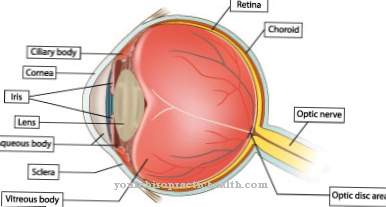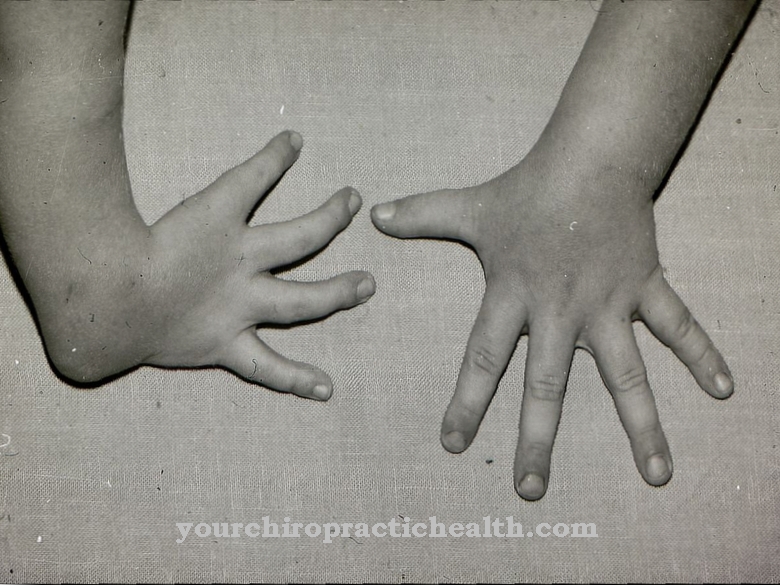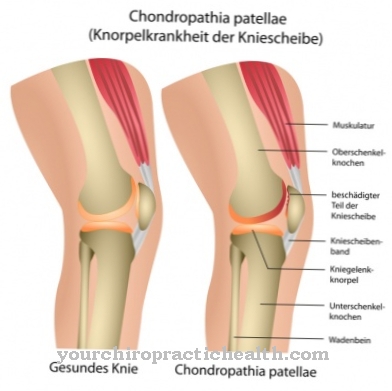The Othematoma is an effusion between the cartilaginous auricle and the cartilage membrane. Since it is usually caused by a shear force such as a blow from the side to the ear, it is also known as a boxer's ear. The othematoma should always be treated promptly, since if left untreated it can lead to complications such as permanent changes in the shape of the auricle and infections, which are far more difficult to treat.
What is an othematoma?

© sirikorn - stock.adobe.com
The accumulation of blood or protein-rich (serous) fluid between the cartilage and the cartilage (perichondrium) of the auricle is called Othematoma designated. The auricle consists of a cartilaginous framework that gives the ear its characteristic shape. The cartilage is covered by a skin of cartilage, which in turn lies against the outer skin. this is rich in blood vessels and nerves.
The skin of the cartilage is usually so close to the cartilage that there is no space between the two structures. The outer skin is also firmly attached to the perichondrium from the other side. However, as a result of trauma it can happen that the cartilage skin becomes detached from the cartilage and a space is created that does not naturally exist, but in which fluid can now collect. The development of an othematoma is the result.
causes
In most cases, an othematoma is the result of external violence. As a rule, shearing and tangential forces acting on the auricle are the cause of the development of the disease. A lateral blow to the auricle during a boxing match is probably the most common cause of the development of the othematoma.
For this reason, the disease bears the name Boxer ear brought in. Furthermore, lying on the kinked ear for a long time can be the cause of the effusion. This is especially typical for people who sleep in a sideways position and very quietly.
Symptoms, ailments & signs
The othematoma appears as a pink-red, bulging, elastic swelling on the front of the auricle. Similar to a blister in burns, it bulges convexly under the skin and can lead to a strong feeling of pressure. Those affected usually do not complain of pain. The ear is often only slightly red and is usually not overheated.
In many cases, however, the effusion can be shifted when pressure is applied from above or from the side. If an infection with bacteria occurs, severe local pain, redness, swelling and overheating can occur. In addition, pus-containing fluid can be secreted from the sore area. Light bleeding is also possible in this case. If an othematoma is not treated, connective tissue overgrows the effusion.
The othematoma becomes solid, grows together with the surrounding cartilage and makes the auricle appear deformed like cauliflower. This occurs especially with recurring effusions that have either not been treated properly or are due to renewed application of force. This complication can easily be averted with early diagnosis and treatment.
Diagnosis & course of disease
The othematoma is usually a visual diagnosis made by the ENT doctor. Appropriate events in the recent past, such as a blow to the affected ear or the appearance of symptoms immediately after waking up, underpin the diagnosis. Imaging procedures such as an ultrasound or X-ray are usually not required.
The diagnosis of an acute othematoma always requires therapeutic intervention, as the disease does not heal on its own. The connective tissue remodeling of the chronic othematoma is not dangerous, but can have an unaesthetic effect. Treatment of the disease at this stage is far more complex and less successful.
Complications
If an othematoma is not treated, the swelling can become inflamed and cause severe pain. In addition, fluid can leak from the sore area and cause severe infections. In the further course, connective tissue overgrowth occurs in the effusion, which is associated with optical changes and chronic pain, among other things. This complication occurs especially with recurrent hematomas that are inadequately treated.
In severe cases, an othematoma can be associated with damage to the eardrum and total or partial hearing loss. Martial artists in particular are affected by this. In addition, a hematoma can seriously damage the surrounding tissue structures. If muscles and nerves are damaged here, the so-called compartment syndrome with permanent sensory disturbances and paralysis of the affected part of the body can occur.
Ultimately, an othematoma can cause severe pain and permanently damage the muscles in the event of recurring trauma. Treatment of an othematoma can promote severe adhesions, bleeding and infection (if there is a drainage) as well as bleeding, secondary bleeding and the formation of scars (if there is surgery). The drug treatment can cause side effects and interactions. Inadequate aftercare can lead to renewed trauma.
When should you go to the doctor?
If there is bleeding or dizziness after an accident or a blow to the ear, it may be an othematoma. A doctor should be consulted if the symptoms have not subsided after a few hours or if they should get worse within a short time. After a serious accident or fall, the emergency services must be called. Depending on the severity of the injury, the first aid worker must provide first aid and place the person in a stable position on their side so that the blood can drain from the ear. Those who repeatedly subject their ears to vibrations - such as boxers and other martial artists - risk permanent disfigurement of the auricle.
Since this visual flaw can also represent a psychological burden, the family doctor and therapist must be consulted. The malformation can possibly be corrected surgically. The othematoma itself is treated by a sports doctor, ear specialist or general practitioner. In the event of severe injuries, the wound must be closed surgically and the blood congestion removed. In the first few weeks after a surgical procedure, the ear specialist has to check the wound healing and, if necessary, prescribe painkillers and anti-inflammatory drugs.The othematoma therefore always requires medical treatment and follow-up care. Failure to do so can lead to serious complications that, in the worst case scenario, can result in hearing loss.
Treatment & Therapy
Since the accumulation of fluid between cartilage and cartilage skin organizes and solidifies over time and can thus lead to deformation of the auricle, the othematoma must always be treated promptly. As a rule, a small skin incision is made on the front of the auricle (incision), through which the fluid can be drained (drainage).
A pressure bandage should then be applied to the ear so that the space between the cartilage and cartilage membrane cannot fill up again with fluid. The pressure bandage supports the adhesion between the two tissues and ensures that the unnatural space closes sufficiently.
Especially with recurring effusions in the same place, a small cartilage window can be created on the back of the auricle. The changed cartilage is cut out, which very well prevents a new othematoma from developing at this point.
Infected othematomas should be treated with medication. Solutions containing antibiotics may be required here. It is also important to have the wound cleaned regularly and thoroughly by an experienced doctor and to avoid re-trauma.
You can find your medication here
➔ Medicines for earache and inflammationOutlook & forecast
With immediate treatment, the prognosis of the othematoma is usually favorable. Most of those affected recover through the use of various therapy methods. Liquids that have formed are removed so that an optical change in the auricle can regress within a few weeks. A pressure bandage is necessary so that no pathogens can enter the organism during the healing process.
Some patients have to undergo surgery if the outcome is unfavorable, otherwise secondary diseases can develop. The procedure is described as simple and rarely leads to unwanted health developments. If, contrary to expectations, complications arise from the operation, a delay in the healing process must be expected. Permanent malfunctions are usually not documented.
If the use of medical care is avoided, the risk of secondary disorders or long-term impairments is significantly increased. In these cases, the prognosis worsens significantly. Deformities of the ear can occur that cannot be adequately corrected in the further course of life. In addition, the repeated emergence of infections is often observed. Overall, this leads to a weakening of the sense of health and thus of the organism. This course can be difficult for high-risk patients in particular.
prevention
The best way to prevent an othematoma is to avoid martial arts. Boxers should ensure they have adequate head protection and should not aim at their opponent's ears. Vulnerable people can fix their auricles to their heads with plasters at night and thus avoid kinking them.
Falling asleep on your back can also help prevent an othematoma from developing. If an othematoma develops despite precautionary measures, immediate treatment can achieve complete healing and avoid chronicity.
Aftercare
In the case of an othematoma, the options for follow-up care are relatively limited in most cases or are not even available to those affected. First and foremost, a quick and early diagnosis of this disease must take place so that the symptoms do not worsen further or complications occur.
Therefore, those affected should consult a doctor at the first symptoms and signs of the disease. As a rule, the symptoms can be relieved relatively well with a slight operation so that there are no complications in the further course. After the procedure, those affected should rest and take it easy, with the sensitive area being particularly well protected.
A pressure bandage should also be worn for several days to prevent infection or inflammation. Even after the procedure, regular controls and examinations are necessary in order to check the condition of the othematoma. Further measures and options for aftercare are usually not available to those affected by this disease and are usually not necessary. The othematoma has no negative influence on life expectancy.
You can do that yourself
An othematoma should be treated by a doctor as soon as possible. After puncturing the swelling, which leads to the swelling of the othematoma, the wound must be well cared for and kept away from dust, dirt and aggressive care products.
The swelling should have completely subsided after a week at the latest. During this period, the affected ear must not be stressed by earmuffs and the like. However, should complications arise, it is best to consult a doctor. Inflammation or bleeding should not be treated on your own as improper treatment can lead to infection and skin damage. A recurrent othematoma requires close monitoring by a doctor. In addition, the patient should perform the measures described after each procedure. In the case of recurring complaints, there are often unknown causes that must be identified and remedied. The patient should look for possible triggers both at work and in private life and examine the connection to the recurrent effusion.
The healing of an othematoma can be supported by various natural remedies. For example, devil's claw, aloe vera and various essential oils promote blood circulation and support wound healing.



.jpg)









.jpg)

.jpg)
.jpg)











.jpg)